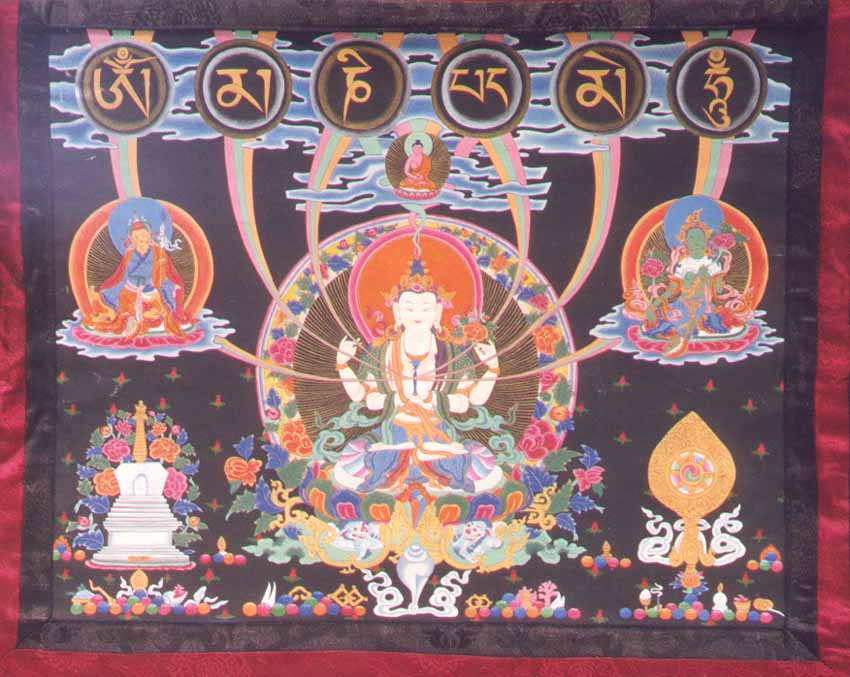

"OM" as the first syllable in the crucial Tibetan Buddhist mantra "OM MANI PADME HUM"
Source: http://www.exoticindiaart.com/paintings/ZE22
(downloaded June 2001)
"Avalokiteshwara. Horizontal Tibetan Thangka Painting. 24" x 20"."
Commentary provided by the website displaying this image:
"A Thangka is a painted or embroidered banner, which is hung in a monastery or a family altar and carried by lamas in ceremonial processions. In Tibetan the word 'than' means flat and the suffix 'ka' stands for painting. The Thangka is thus a kind of painting done on flat surface but which can be rolled up when not required for display. The most common shape of a Thangka is the upright rectangular form. One does also find horizontal oblong banners influenced probably by the format of Chinese horizontal hand scrolls, like this particular thangka.Shadakshari Lokeshvara, the large central figure in this thangka, is an important manifestation of the bodhisattva Avalokiteshvara, who is of special significance to the Tibetans; the Dalai Lamas are said to be incarnations of this form of the bodhisattva.
Shadakshari means six syllabled, the six syllables are om mani padme hum and constitute the famous mantra of this bodhisattva that is constantly chanted by devout Tibetans. The mantra is considered so efficacious that it has been carved on numerous rock faces throughout Tibet. Here it can be seen inscribed in large alphabets, dominating the entire upper part of the painting.
Although bejewelled and crowned, the bodhisattva is represented as a perfectly poised yogi seated with his legs closely locked in the lotus posture. His eyes are downcast, as if in meditation.
An antelope skin is over his left shoulder, with the antelope's head on his left breast.
He has four hands. The principal hands are raised to the chest with the palms enjoined in namaskarmudra, the gesture of prayer or greeting, and hold a wish-fulfilling gem. The upper right hand is in the vitarka mudra, or the gesture of reasoning and explanation, while the corresponding left hand holds the lotus, the distinctive emblem of this bodhisattva.
An extremely important singularity in this thangka are the two deities to the right and left of Lokeshvara. To his right is Padmasambhava, and to the left is the Green Tara. What is important is that the three colored loops which begin with Lokeshvara and end at the mantra above, pass through Padmasambhava while going to aum and going to Hum passes through Green Tara. Now the Mantra of Tara is Hum and that of Padmasambhava is Om, thus this thangka reiterates the relation of these mantras to the respective deities.
In the lower part of the painting, at the left can be seen a Stupa and the right is seen a Golden Wheel or Dharmachakra.
This description by Nitin Kumar, Executive Editor, Exotic India.
References:
=Beer, Robert. The Encyclopedia of Tibetan Symbols and Motifs. Boston: Shambhala Publications, 1999.
=Chakraverty, Anjan. Sacred Buddhist Painting. New Delhi: Roli Books, 1998
=Fisher, Robert E. Art of Tibet. London: Thames and Hudson, 1997.
=Getty, Alice. The Gods of Northern Buddhism. New Delhi: Munshiram Manoharlal, 1978.
=Lipton, Barbara, and Ragnubs, Nima Dorjee. Treasures of Tibetan Art: Collection of the Jacques Marchais Museum of Tibetan Art. New York: Oxford University Press, 1996.
=Pal, Pratapaditya. Art of Tibet. Los Angeles: The Los Angeles County Museum of Art, 1990.
=Rhie, Marylin M. & Thurman, Robert A.F. Wisdom and Compassion: The Sacred Art of Tibet. London: Thames and Hudson, 1996.
== Indian Routes index == Indian Routes sitemap == Glossary == FWP's main page ==